Balconies are a valuable feature in any home or apartment, offering space to relax, entertain, or enjoy fresh air. But with their constant exposure to changing weather, they are also highly vulnerable to water damage. Over time, even the smallest cracks or faults in construction can lead to serious leaks. Unfortunately, many homeowners don’t realise there’s an issue until the water damage becomes visible—by which time it may have already caused structural problems. That’s why early and accurate balcony leak detection is essential.
In this blog, we’ll explore what causes balcony leaks, how to identify early warning signs, how detection is done professionally, and why it’s crucial to act quickly. You’ll also learn the benefits of professional services and tips for long-term leak prevention.
Why Balcony Leaks Happen
Balconies are built with waterproof membranes beneath the tiles or surface to prevent water from penetrating the structure. However, these membranes can fail over time due to natural wear, movement in the building, improper installation, or weather-related damage. Other causes of leaks include poor drainage, cracked tiles or grout, and blocked outlets. As water begins to seep through small openings, it can reach the underlying concrete slab or framework, leading to internal damage and even posing risks to the structural integrity of the property.
Common Signs You May Have a Balcony Leak
Often, a balcony leak isn’t visible at the surface level. Instead, damage may first appear inside the home. Water stains on the ceiling below the balcony, peeling paint, damp patches on walls, and musty odours are all common warning signs. You may also notice mould growth, soft spots in flooring, or rust appearing on nearby metal components. On the balcony itself, look for signs such as loose tiles, deteriorated grout, water pooling, or efflorescence (white powdery stains caused by salt deposits). These are all strong indicators that balcony leak detection is needed.
How Professional Balcony Leak Detection Works
Professional leak detection goes far beyond a simple visual inspection. Experts use specialised tools and methods to pinpoint the exact source of the leak without damaging the surrounding structure. Common techniques include:
- Thermal imaging, which detects temperature differences caused by moisture.
- Moisture meters, which assess the level of dampness within materials.
- Dye testing, where coloured water is used to trace the path of the leak.
- Pressure testing, to check for weak points in plumbing or drainage systems.
These tools allow for precise detection, helping to avoid unnecessary repairs and ensuring the issue is properly resolved at the source.
Why Early Leak Detection is Important
The longer a leak goes undetected, the more damage it can cause. Moisture trapped within walls or flooring can weaken structural elements, rot timber, cause concrete cancer, and create ideal conditions for mould. These problems not only lead to expensive repairs but may also pose serious health risks to occupants. Early balcony leak detection helps homeowners identify and fix leaks before they escalate, saving both time and money in the long run. It also ensures that any waterproofing work or repairs are targeted and effective.
DIY vs Professional Detection: What’s Better?
While some signs of balcony leaks can be spotted by homeowners, finding the actual source of the leak is not always straightforward. DIY methods, such as applying sealants or regrouting, may offer short-term relief but rarely address the root cause. Without proper tools and expertise, leaks often return—sometimes worse than before. Professional balcony leak detection ensures a thorough assessment using advanced technology, eliminating guesswork. This allows for more accurate repairs and longer-lasting results. In most cases, investing in professional detection early can prevent a small issue from becoming a major renovation project.
Benefits of Timely Balcony Leak Detection
Prompt detection of balcony leaks offers a wide range of benefits, including:
- Preventing structural damage to floors, ceilings, and walls.
- Avoiding health hazards like mould and mildew.
- Reducing repair costs by catching issues early.
- Protecting the property’s value and maintaining its appearance.
- Ensuring balcony safety, especially in multi-storey buildings.
- Extending the life of your balcony and waterproofing system.
By acting quickly, homeowners can maintain the functionality and beauty of their outdoor spaces while avoiding major disruptions and financial setbacks.
How to Prevent Balcony Leaks in the Future
Once a leak has been identified and repaired, prevention becomes the next priority. Here are a few tips to keep your balcony leak-free long-term:
- Ensure proper drainage by regularly clearing outlets of debris.
- Inspect tiles and grout every few months for signs of cracks or wear.
- Avoid heavy water exposure, such as frequent hosing or pooling.
- Maintain waterproof membranes with professional resealing when needed.
- Schedule regular inspections, especially in older properties or after extreme weather.
With proactive care and timely maintenance, your balcony can stay dry and damage-free for many years to come.
Conclusion: Don’t Ignore the Signs—Detect Balcony Leaks Early
Balconies should enhance your home’s value and lifestyle—not become a source of stress or costly repairs. When water begins to penetrate your outdoor space, it’s a sign of deeper issues that can quickly spiral out of control. Professional balcony leak detection allows you to catch and fix these problems at their source before they affect your property’s structure, safety, or appearance.
If you’ve noticed any signs of water damage around your balcony—or simply want peace of mind—don’t wait. Call in the experts, schedule a thorough inspection, and protect your home with confidence. A small step today can prevent major damage tomorrow.

